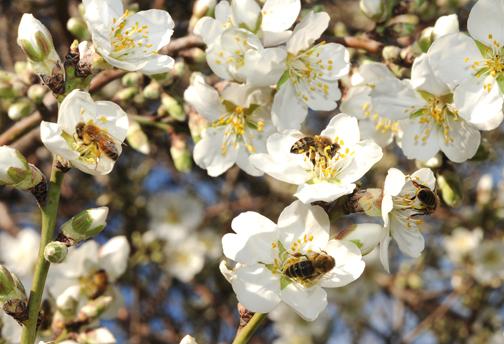Varroa Mite
Bee Health Fugitives
Bee Health: Varroa Mite Is Public Enemy No. 1
By Laurie Greene, Editor
The varroa mite is “Public Enemy No. 1” for bees, according to Becky Langer, the North American Bee Care manager for Bayer CropScience. “It’s the giant tick that’s attaching to [bees],” said Langer, “transmitting viruses and bacteria. This mite has to be constantly managed and we’ve seen very high levels. When our bee experts were out visiting with people last fall, people were reporting very high levels of mites. So we anticipate high [bee] losses coming out of this winter because of the cyclic effect of the mite.” Langer explained. “It really re-emphasizes the necessity of controlling that mite—all the time—and staying on top of it.

Bayer Bee Health’s Feed a Bee Program
Commenting on other “Most Wanted Criminals” against bee health, Langer discussed recent research findings that well-fed bees are better able to defend themselves against the notorious nosema, a fungi-related parasite. “They actually found higher counts of nosema in those bees, but the well-fed bees could manage the nosema population—as opposed to not-well-fed bees.”
“That of course ties into Bayer Bee Care Program‘s Feed a Bee Program and its forage and nutrition initiative,” commented Langer. Launched last year to address the lack of food and habitat for bees Feed a Bee worked with more than 250,000 people and 75 partners to plant 65 million flowers and thousands of acres of forage across the country. “We’ve got to be feeding these bees better,” Langer reinforced.
According to their website, this year, Feed a Bee kicks off the spring with the launch of a new song and video for children of all ages. Other ways people can become involved with the program to help these hardworking insects are: request a free packet of wildflower seeds, for a limited time while supplies last; commit to growing pollinator-attractant plants of your own; and locate Feed a Bee plantings in your own communities on the interactive partner map. You can also tweet a ? emoji and #FeedABee to have Bayer plant on your “bee-half.”
Langer commented on crop protection products—”the usual suspects”—by stressing the importance for growers to follow labels. “If that’s the case and they are used properly and in the proper settings, there is no long-term effect on colony health,” she said. “Really, where we see colony health problems correlates well with the varroa mite and with forage and habitat issues.”
Among the Feed a Bee Program collaborators in California are: Wilbur-Ellis, San Francisco, CA; Bee Happy Apiaries, Vacaville, CA; Carmel Valley Ranch & Golf Course; PROJECT APIS M.; and Vitamin Bee.
__________________________________________
Resources:
Fleming, James C.; Daniel R. Schmehl; James D. Ellis, “Characterizing the Impact of Commercial Pollen Substitute Diets on the Level of Nosema spp. in Honey Bees (Apis mellifera L.),” PLOS ONE [an international, peer-reviewed, open-access, online publication], July 30, 2015.












